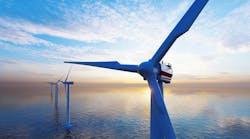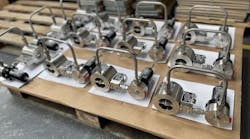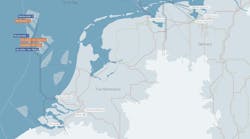The techniques applied to control downhole sand production have not changed for many years. Almost every sand control solution involves the installation of a pipe-based filter that is either gravel packed or left as a "stand alone" screen. Gravel packing has evolved over more than 70 years, but still involves complex fluid and gravel pumping operations. Stand-alone screens, while being operationally very simple, do not support the formation, leading to a number of well reliability and production issues.
Expandable sand screens were developed to overcome the shortcomings of both existing techniques, while also providing some unique benefits. The first commercial application of this technology took place in January 1999. Since then, their use has spread quickly to all parts of the world and in many diverse applications. As of November 2000, over 23,000 ft of expandable sand screen had been run in 25 applications, but US acceptance was slower in coming. Not until 2000 did Chevron complete a sidetrack well, using expandable sand screens for sand control, making it the first in the Gulf of Mexico.
The West Delta 117 Field was discovered in 1962 and has since been developed with over 100 wells drilled in the field. The pay sands are stacked deltaic deposits from 4,900 ft to 14,500 ft, and range in age from early Pleistocene to late Miocene. Sand control is installed in most wells in the field to address historical sand control problems.
In May 2000, the OCS-G 9690 G-7 S/T1 well was drilled as an extended reach well to a seismic bright spot in the B-1 sand at 4,865 ft true vertical depth (TVD). One other take point in the B-1 sand had successfully produced gas in a separate fault block with a high rate water-pack installed for sand control. The G-7 S/T1 well logged 16 ft corrected gas on water. Initial appraisal indicated that completing this well with conventional gravel pack would not generate the best economic solution and that a completion with stand-alone screens would not be sufficiently durable to assure a producing life with adequate longevity.
An expandable sand screen offered the ability to control sand production without a frac-pack, but also promised to overcome the plugging and erosion problems of stand-alone screens. Further, the elimination of the frac-pack brought the project into economic reality by lowering the initial cost as well as reducing the risk of early water production compromising gas production.
The development of the expandable sand screen was created by cutting base-pipe in an overlapping engineered slot pattern around its circumference. The pipe can then be expanded by various means, most simply by driving a swedging mandrel through its bore. The slotted tube has several desirable features as the base-pipe for an expandable screen:
- Upon expansion, its diameter can be increased by over 100%, if necessary, allowing elimination of large annular gaps.
- It provides a large inflow area when expanded (typically greater than 30%) that is ideal for a screen containing a highly porous filter membrane.
- The expanded base pipe internal diameter is larger than the swedging mandrel diameter. This surplus expansion phenomenon allows the mandrel to travel freely, but more importantly, allows the expandable screen to achieve a tight fit inside a confining wellbore, thus providing for wellbore support.
Expandable pipe
The expandable base pipe is covered longitudinally with overlapping sheets of woven wire mesh as the filter medium. Tests with these filters showed that careful selection of aperture size for a given sand mixture enabled plugging to be minimized with virtually all sand being held back. The filter media is sandwiched between the base pipe and an outer expandable protective shroud.
A key component of the system is an expandable sand tight connector, which allows the entire screen assembly to be expanded to the same dimensions while allowing flow through it. As the sand screen is expanded, it eliminates the annulus between the screen and the borehole. This feature has further benefits:
- Eliminating the screen/wellbore annulus effectively permits smaller diameter sandface completions for the same production bore size.
- Reducing the final bore size can lead to cost reductions of up to 20% on the total well costs.
When an expandable screen is expanded to fit tightly in a wellbore, the ability to manage the reservoir inflow or treat the reservoir is greatly increased. With the annulus eliminated, it is possible to set devices within the screen to isolate sections or to squeeze treatment fluids into the formation and there is a dramatic reduction in the ability of sand particles to move around under producing conditions. In theory, sand particles are rapidly stabilized, resulting in reduced erosion and screen plugging. A further fundamental benefit of expanding the screen to the wellbore diameter is the dramatic increase in available filter area. In all studies, increasing filter area has been shown to be the best means of resisting plugging.
Well productivity
Formation productivity was to be maximized by minimizing water production and eliminating sand production. Earlier experience with the weakly consolidated formation indicated that a conventional frac-pack could extend fractures in this clean blocky sand from the gas producing intervals down into the zone with strong water production.
Attention was required to ensure that the interface between the formation and the expandable sand screen (perforation tunnels) would maintain an adequate permeability. Perforation debris in tunnels will compromise their productivity whether the tunnels are pre-packed or not. The removal of this debris through under-balanced surging was the initial step to ensure the integrity of the tunnel permeability.
Conventional practice is then to pre-pack perforation tunnels to preserve or improve permeability at the formation/wellbore interface. Expandable sand screen deployment does not allow for this to be done. But it is clear however that if the perforation tunnels collapse and formation fines are liberated en masse, the permeability of the tunnels and the screens will be irreparably impaired.
This is most likely for poorly sorted sands, but for well-sorted sands, a managed ramp up of production allows the tunnels to pack themselves with formation sand against a properly sized expandable sand screen while allowing fines to pass through the screens. The resulting permeability of the tunnels is not dissimilar to that of the formation itself.
The well was to be perforated with filtered seawater in the wellbore, after which some fluid loss to the formation was to be expected. To control this, a sheared and filtered pill was spotted across perforations. This should effectively control the fluid loss during completion string installation and could be flowed back through the expandable sand screen without any acid being needed as a breaker.
The choice of perforation charges was between a deep penetrating charge to bypass any formation damage that may have occurred while sidetracking the well (otherwise usually performed by the frac-pack), and big hole charges to provide the maximum inflow area. One of the advantages of the expanded screen is the generous inflow. This brings low inflow velocities and pressure drops across the screen. In turn, this reduces screen erosion, but more importantly, limits the transportation of formation sand and fines from the formation along the perforation tunnels. Therefore, to take advantage of the inflow area of the screen and to minimize the transport of plugging fines along the perforation tunnels, big hole charges were selected with a shot density of 16 spf and 90 degree phasing with a total area of 10.19 sq in/ft. The perforations were to be shot underbalanced to remove perforation debris
Screen selection
The interval selected for perforation was chosen to minimize the potential for water coning, but was also constrained by the length of available screen units. The screen in question was a single joint unit, which had been procured for a different well, and had an effective length of 38 ft. The perforation interval was therefore limited to 30 ft (9,584-9,614 ft measured depth), providing 4 ft of screen overlap at each end of the perforation interval.
Expandable sand screen units had been procured for another Chevron well that proved to have mechanical impediments to re-completion, and so were available for the G-7 re-drill, if the specifications proved to be appropriate. The unexpanded base pipe size (4-1/2 in.) was correct for the 7 in. 23 lbs/ft casing for G-7 S/T1, and the range of expansion cones on hand allowed for some flexibility for the engineers on location if the drift run proved an ID less than API 5CT specification. Based on an evaluation of the formation particle size distribution by Chevron, the filter medium with 150m aperture was confirmed to be acceptable (this aperture size was the smallest available at that time).
A single integral expandable sand screen joint combining a standard expandable sand screen joint with integral expandable top and bottom connectors was made up with a bull plug at the bottom end. The expandable top connector containing the expansion cone was made up to the seal bore extension and thus to the packer.
Expansion of screen
Screen expansion is achieved by driving a hardened expansion cone through the unexpanded base pipe. The base pipe ID expands slightly more than the OD of the expansion cone. The expansion cone selection is done immediately prior to running the screen to capture all the available information regarding the wellbore.
In this situation, the API 5CT ID and the API 5CT drift ID of the G-7 S/T1 casing each straddled two expansion cones sizes. An expansion cone selection too large could prevent expansion of the expandable sand screen completely or prevent it being accomplished with the string weight available on the rig. An expansion cone too small, would leave the screen expanded but not tight against the liner, introducing a micro-annulus between the screen and the liner, undermining the creation of an effective packing of perforation tunnel by allowing produced sand to be continually leached from the tunnel.
It was hoped that a bit and scraper/drift run would clarify the decision process, but this was not deemed an efficient use of rig time. So the expandable sand screen engineer made some unproven assumptions on the quality of the casing tubulars, and aimed for the maximum possible expansion consistent with the API 5CT ID of the casing. While there is no doubt that this contributed to the unusually high expansion forces required to initiate and maintain expansion of the screen, the tight fit that resulted has ensured that sand free production has been maintained throughout the production history to date.
Conclusions
The application of an integrated completion using expandable sand screens as the primary sand control completion technique proved to be an enhanced economic solution when compared to a conventional gravel pack completion. The understanding that the sand screen and the perforation tunnels comprise a system that must be treated with the care they deserve, was essential to achieving the production rates necessary to exploit the successful installation of the completion.
Some of the risks associated with the screen installation process were poorly understood at the time. These are better known now, as the number of expandable sand screen installations has increased so rapidly around the world. But it would be misleading to ignore the fact that this job benefited from a certain amount of good fortune.
Torque and drag modeling of the expansion string would have provided better prediction of the weight that could be applied to the expansion cone within the well bore trajectory at completion depth. Current practice is to invest greater attention to this aspect of fixed cone expansions. Post-completion pressure transient testing would have provided information on completion efficiency and been of great value in evaluating future projects of this kind.
Acknowledgement
Chevron and Weatherford granted permission to publish this paper. Drill-site personnel contributed to the success of the completion.









